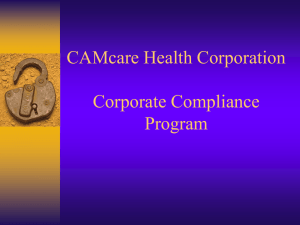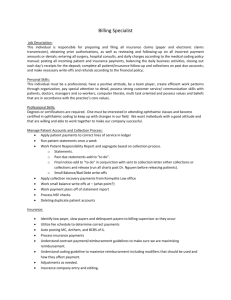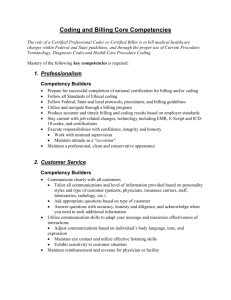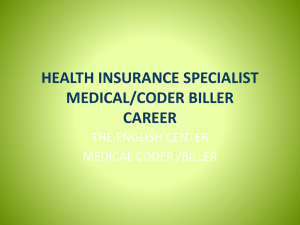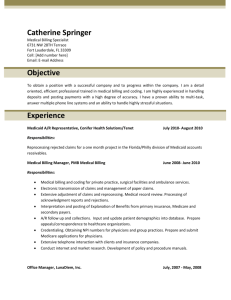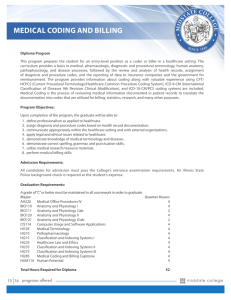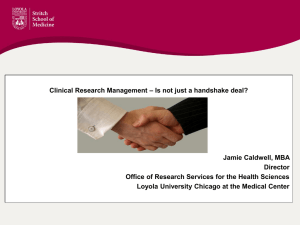HITC155 Reimbursement Methodologies
advertisement
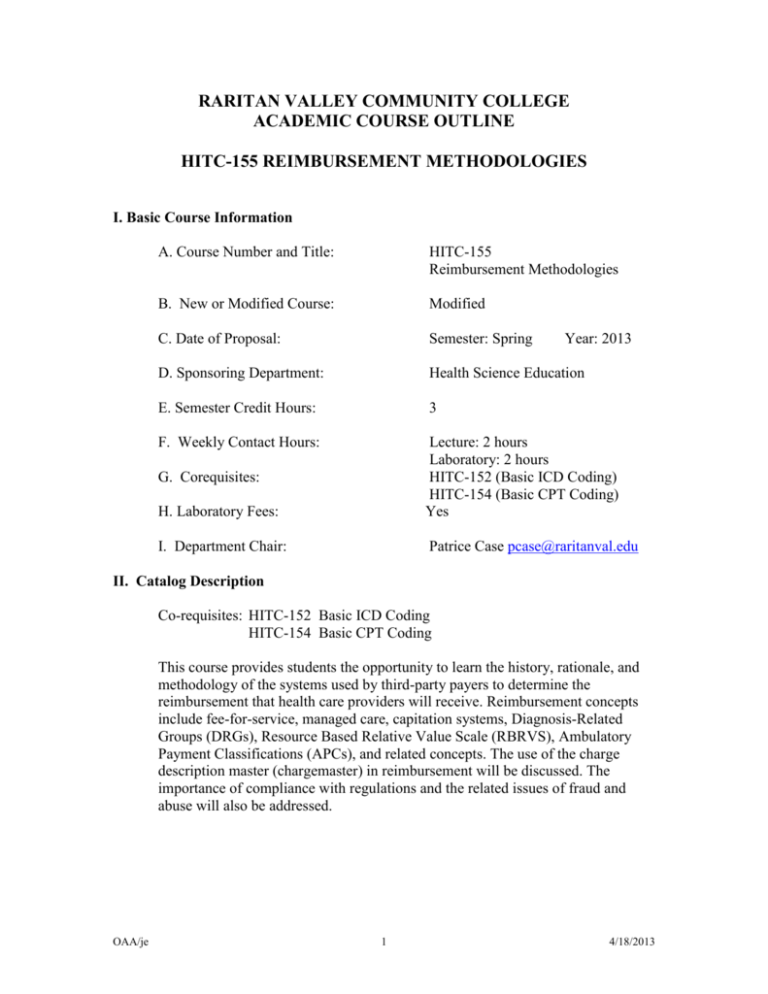
RARITAN VALLEY COMMUNITY COLLEGE ACADEMIC COURSE OUTLINE HITC-155 REIMBURSEMENT METHODOLOGIES I. Basic Course Information A. Course Number and Title: HITC-155 Reimbursement Methodologies B. New or Modified Course: Modified C. Date of Proposal: Semester: Spring D. Sponsoring Department: Health Science Education E. Semester Credit Hours: 3 F. Weekly Contact Hours: H. Laboratory Fees: Lecture: 2 hours Laboratory: 2 hours HITC-152 (Basic ICD Coding) HITC-154 (Basic CPT Coding) Yes I. Department Chair: Patrice Case pcase@raritanval.edu G. Corequisites: Year: 2013 II. Catalog Description Co-requisites: HITC-152 Basic ICD Coding HITC-154 Basic CPT Coding This course provides students the opportunity to learn the history, rationale, and methodology of the systems used by third-party payers to determine the reimbursement that health care providers will receive. Reimbursement concepts include fee-for-service, managed care, capitation systems, Diagnosis-Related Groups (DRGs), Resource Based Relative Value Scale (RBRVS), Ambulatory Payment Classifications (APCs), and related concepts. The use of the charge description master (chargemaster) in reimbursement will be discussed. The importance of compliance with regulations and the related issues of fraud and abuse will also be addressed. OAA/je 1 4/18/2013 III. Statement of Course Need A. This course fulfills the “knowledge cluster content and competency” required by the American Health Information Management Association. Earning a credential validates one’s competence as a professional in the health information management industry to employers and the public. This credential requires an associate's degree and successful performance on the RHIT certification exam. Students must successfully complete and meet the learning objectives as defined for this course in order to qualify to take the national certification examination. B. Students will use the AHIMA Virtual Lab (Vlab). In the AHIMA Vlab, students will gain hands-on experience with the Quantim Encoder, which will familiarize them with encoding software that is likely to be encountered in the workplace. C. This course generally transfers as a program requirement in health information technology or medical coding. IV. Place of Course in College Curriculum A. Free Elective B. This course does not serve as a General Education course. C. This course meets a program requirement for the Health Information Technology A.A.S. degree program and the Medical Coding Certificate program. D. To see course transferability: a) for New Jersey schools, go to the NJ Transfer website, www.njtransfer.org; for all other colleges and universities, go to the individual websites. V. Outline of Course Content A. B. C. D. E. F. G. H. I. Prospective payment system Diagnosis Related Groups Ambulatory Payment Classifications ASC Groups Resource Based Relative Value Scale Third party payers Billing and insurance procedures Explanation of benefits Quality Improvement Organizations (QIO) and their role in the payment process J. Charge master description and maintenance K. Managed care/capitation OAA/je 2 4/18/2013 L. M. N. O. Compliance issues Health plan claims processing and coding Billing for healthcare services using codes Auditing and monitoring the coding process for regulatory compliance VI. General Education and Course Learning Outcomes A. General Education Learning Outcomes: At the completion of the course, students will be able to: 1. Analyze and discuss information from a national report on health statistics. (GE-NJ *) 2. Use a variety of research tools including an encoder to assign appropriate codes. (GE-NJ 4,IL) 3. Use information from the Federal Register, the OIG Work Plan, and the text to produce a plan for implementing a voluntary compliance program. (GE-NJ 1) (* Embedded critical thinking) B. Course Learning Outcomes: At the completion of the course, students will be able to: 1. Apply policies and procedures for the use of clinical data required in reimbursement and prospective payment systems (PPS) in healthcare delivery. (Domain I: Subdomain D:1) 2. Apply policies and procedures to comply with the changing regulations among various payment systems for healthcare services such as Medicare, Medicaid, managed care, and so forth. (Domain I: Subdomain D:2) 3. Support accurate billing through coding, chargemaster, claims management, and bill reconciliation processes. (Domain I: Subdomain D:3) 4. Use established guidelines to comply with reimbursement and reporting requirements such as the National Correct Coding Initiative. Domain I: Subdomain D:4) 5. Compile patient data and perform data quality reviews to validate code assignment and compliance with reporting requirements, such as outpatient prospective payment systems. (Domain I: Subdomain D:5) 6. Ensure accuracy of diagnostic/procedural groupings such as DRG, APC, and so on. (Domain I: Subdomain D:6) OAA/je 3 4/18/2013 7. Demonstrate understanding of basic healthcare finance concepts and how health information functions and operations impact these concepts. 8. Explain the process by which standardized billing forms are compiled and the key components related to health information functions. 9. Demonstrate knowledge of the different methods used for submitting claims to payers, and the pros and cons of each. 10. Explain how coding impacts payer editing and claims adjudication and the impact of incorrect coding for patients and providers. 11. Describe the concepts involved with Prospective Payment Systems. 12. Define major terms used in the Managed Care Environment. 13. Describe the mechanics of APC, DRG and RBRVS payment schedules used by Medicare. 14. Plan and organize a billing compliance program in the hospital environment. VII. Modes of Teaching and Learning A. B. C. D. E. lecture/discussion small-group work computer-assisted instruction laboratory (Virtual Lab) independent study VIII. Papers, Examinations, and other Assessment Instruments A. exams B. project IX. Grade Determinants A. Exam I (20%) BILLING and PAYMENT METHODS FOR HOSPITALS Test will consist of multiple choice, True/False and Short Answer Questions related to Finance Operations in the Hospital Setting. B. Exam II (20%) BILLING and PAYMENT METHODS FOR PHYSICIAN OFFICE Test will consist of multiple choice, True/False and Short Answer Questions related to Finance Operations in the Physician Office Setting. C. Exam III (20%) BILLING and PAYMENT METHODS FOR ANCILLARY SERVICES OAA/je 4 4/18/2013 Test will consist of multiple choice, True/False and Short Answer Questions related to Billing Operations in the Ancillary Setting. D. Final Exam (20%) COMPREHENSIVE FINAL EXAM Test will consist of multiple choice, T/F, and short answer questions related to all material covered during the semester. E. Class Project (20%) BILLING COMPLIANCE AUDIT At the completion of the hospital billing and payment module the class will be required to perform a billing compliance audit. A 3-6 page paper will be required. Written guidelines and criteria will be provided at the time project is assigned. X. Texts and Materials A. suggested textbook: Principles of Healthcare Reimbursement, Anne B. Casto, RHIA, CCS; and Elizabeth Layman, PhD, RHIA, CCS, FAHIMA, AHIMA (Please Note: The course outline is intended only as a guide to course content and resources. Do not purchase textbooks based on this outline. The RVCC Bookstore is the sole resource for the most up-to-date information about textbooks.) XI. Resources A. Since this is an online course, student will need the use of a computer for Webstudy and research on the internet. OAA/je 5 4/18/2013

